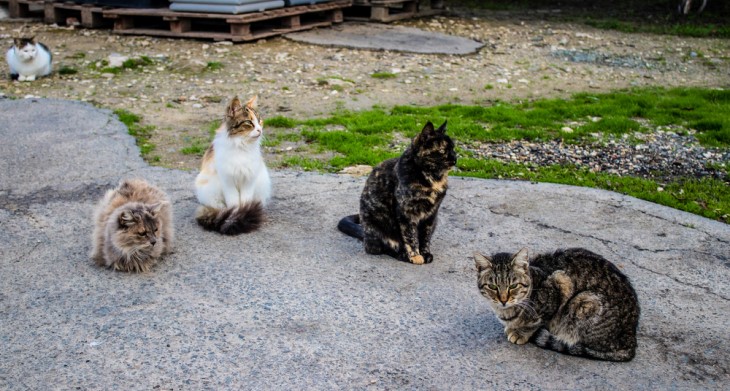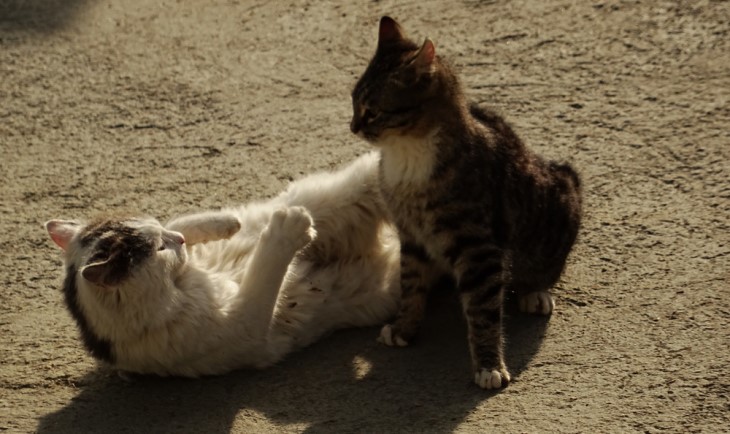
As the saying goes, "good fences make good neighbors," but what if your neighbors are of the feline variety? While cats can bring a sense of charm and liveliness to the neighborhood, having them venture into your garden or office uninvited can pose challenges, especially if you have cats of your own or other pets you want to protect. Perhaps you'd like to feed them but not for them to follow you home. Luckily, there are many effective, non-harmful strategies to deter cats from your property while maintaining a friendly coexistence with our furry friends. This comprehensive guide provides you with a thorough plan of action for each strategy, ensuring that you can execute these tactics efficiently and effectively.

Cats, with their heightened sense of smell, are particularly sensitive to certain aromas. Incorporating plants into your landscape that emit smells that cats find uninviting can effectively keep them at bay. The following are examples of such plants, each with its unique characteristics that can contribute to both the aesthetic appeal and cat-resistant nature of your garden.
1. Coleus Canina: Also known as "Scaredy Cat plant", Coleus Canina has a pungent odor that cats find off-putting, even though it is barely detectable to humans. This plant grows well in various conditions and is recognized for its spiky foliage and blue or purple flowers.
2. Lavender: A popular plant in many gardens, lavender is loved by humans for its vibrant color and calming fragrance. However, cats find the strong scent of lavender less pleasing, making it a good choice for a cat deterrent. Moreover, lavender has the added benefit of attracting pollinators like bees and butterflies to your garden.
3. Rosemary: A hardy, drought-resistant plant, rosemary is an excellent herb for cooking and a great cat deterrent. It produces a strong aroma that cats typically avoid. Rosemary is also a robust plant that can thrive in various climates.
4. Rue: Rue has a powerful scent that is known to deter cats, but it should be used with caution. This plant can cause skin irritation in some people and the strong smell can be overpowering, so it's best planted in areas with less human traffic.
When incorporating these cat-repellant plants into your garden, it's important to consider how they fit into your current landscaping plan. Coleus Canina, for example, with its spiky foliage and bright flowers, can provide a nice contrast to rounder, softer plants. Lavender and rosemary, in addition to their deterring properties, can be planted near outdoor seating areas for humans to enjoy their pleasant smells. Just remember to plant rue in an area that's not often frequented by people due to its potential to cause skin irritation.
Introducing these new plants into your garden requires some planning, but the effort is well worth it. Not only will your property become less inviting to local cats, but the added greenery and color will also enhance your garden's visual appeal. Consulting with a local nursery or garden center can also provide useful insights into the best ways to integrate these plants into your existing landscape.
Most cats are notoriously averse to getting wet. This aversion provides an opportunity to use water as an effective, non-harmful deterrent. Motion-activated sprinkler systems serve this purpose brilliantly. When a cat triggers the sensor, it gets an unexpected shower, which can quickly dissuade it from trespassing onto your property.
While selecting a motion-activated sprinkler system, it's important to choose environmentally-friendly models that are efficient in water usage. After installation, monitoring and adjusting the sensor sensitivity as required will ensure that it targets the cat without causing unnecessary water wastage. Over time, local cats will associate your garden or yard with these surprise showers and be less inclined to visit.

An unsecured trash bin is akin to an open buffet invitation for cats. By properly securing your trash bins, you can discourage these opportunistic creatures from rummaging for food. Investing in trash bins with locking lids is a straightforward solution. Alternatively, you can store bins inside a secure area such as a garage or shed.
Moreover, cleaning up any spills promptly and keeping the area around the bin tidy minimizes enticing odors. Reducing the accessibility and appeal of your bins will have a direct impact on the frequency of feline visits.
Physical boundaries, when appropriately designed, can serve as effective deterrents. For instance, adding roller bars or loosely-tied netting to the top of fences can make it difficult for cats to maintain their balance and climb over. Keeping gates closed when not in use and regularly checking for holes or gaps that cats can squeeze through can help in maintaining a cat-free space.
Remember, cats are skilled climbers, so the modifications need to be effective enough to discourage their agile attempts. For example, roller bars at the top of a fence can create an unstable surface that cats find hard to navigate, thus deterring them from climbing over.
How to keep cats from entering your building
Taking a break for a moment from our list (we'll be right back to it!), what if you don't live in a house but in a residential building? Keeping cats from entering residential buildings requires a slightly different approach than deterring them from your garden or yard. Nonetheless, several of the previously mentioned strategies still apply, and a few specific methods can be quite effective.
- Firstly, make sure all potential entrances such as doors, windows, and ventilation grills are kept closed, especially when the property is vacant. A small opening can be an inviting opportunity for a curious cat to explore. Invest in door and window screens to allow for airflow without welcoming unwanted guests.
- As with your garden or yard, keeping your building and its surroundings clean is vital. Regularly remove any trash or food scraps that may attract cats, and secure garbage bins tightly. The aroma of food can lure cats from a considerable distance, so the absence of these enticing smells will make your building less appealing.
- Just like in the garden, commercial cat repellents can be helpful in this scenario as well. Spray or place these products around entry points to create an invisible barrier of scent.
- For multi-story buildings or properties with fire escapes, consider installing cat-proof fencing or netting to prevent cats from climbing up and gaining access to balconies or windows.
- Lastly, ultrasonic devices can be installed near entrances. The high-frequency sound is irritating to cats but nearly inaudible to humans, making them an effective deterrent.
It's important to remember that each building is unique, so some strategies may be more effective than others. It might take some time to find the right combination that works for your property, but with persistence and patience, you can keep your residential building cat-free without causing harm to these curious creatures.
5. Apply Commercial Cat Repellents
For those looking for an easy solution, various commercial cat repellents, available in granules and sprays, are designed to deter cats without causing harm.
These products are typically made using scents that are unpleasant to cats, providing an invisible barrier against their visits. The science behind these products lies in cats' exceptional sense of smell, which is far more sensitive than that of humans. By using these repellents around the borders of your property or near entry points, you can create an aromatic force field that felines will prefer to avoid.
When shopping for these repellents, it's essential to read customer reviews to gauge their effectiveness. Following the provided instructions is crucial to ensure that these products are used safely and as effectively as possible. Remember, every cat is unique, and what works for one might not work for another, so some experimentation may be necessary.
6. Install Ultrasonic Devices
In the technology-driven world of today, even wildlife deterrence has seen innovative solutions. Ultrasonic devices have emerged as a popular, non-invasive method to keep cats away. These devices emit high-frequency sounds that are beyond the range of human hearing, but are uncomfortable for cats.
It's worth noting that not all ultrasonic devices are created equal. It's recommended to read reviews and conduct research to ensure that you choose a model that is both effective and does not disturb other wildlife. Once installed, these devices should be placed strategically around your property for the maximum effect, ensuring the sound coverage encompasses the entire area you wish to protect.
Creating a cat-free property is not about chasing cats away or causing them harm. Instead, it's about making your space less appealing to them. The goal is to encourage these cats to find other places that are more welcoming, where they won't be startled by sprinklers or find their paths blocked. It's about coexisting with the wildlife around us, understanding their habits and needs, and making adjustments so that both humans and animals can thrive. Patience, respect, and a touch of creativity are all that's needed to live harmoniously with our feline neighbors. Let's share our world in a way that is friendly, professional, and considerate, fostering an environment of mutual respect and understanding. Here's to a peaceful cohabitation!